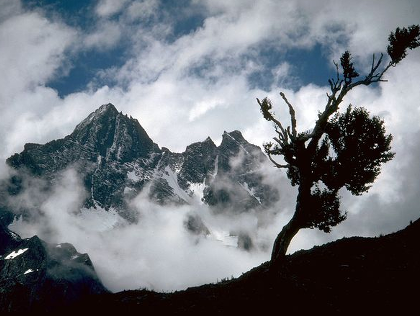
Himalayan glaciers – for years one of the poster children of the “man-made global warming is real and we’re all doomed” movement – are in no imminent danger whatsoever, a new study has found. (h/t GWPF and Watts Up With That?)
Of the 2018 glaciers mapped and monitored for the survey, nearly 87 per cent were found to be stable while only 12 per cent were found to be in retreat. These real-world observations are in marked contrast to the predictions by the Intergovernmental Panel on Climate Change (IPCC) in its 2007 report that the Himalayan glaciers could disappear “by 2035.”
The IPCC was subsequently forced to disown the claim after it emerged that it came not from a peer-reviewed study but from an interview given by an Indian glaciologist to an obscure Indian environmental magazine called Down To Earth. In a game of Chinese whispers, this erroneous claim was then repeated in New Scientist, quoted in a report by environmental campaigning group WWF, and then cited as fact by the IPCC.
What made the story even murkier was that the glaciologist, Syed Hasnain. was subsequently employed by a company run by the head of the IPCC, Rajendra Pachauri, a man who arguably has a strong vested interest in ramping up the global warming scaremongers’ narrative.
As Christopher Booker reported in 2010:
Dr Syed Hasnain, has for the past two years been working as a senior employee of The Energy and Resources Institute (TERI), the Delhi-based company of which Dr Pachauri is director-general. Furthermore, the claim – now disowned by Dr Pachauri as chairman of the IPCC – has helped TERI to win a substantial share of a $500,000 grant from one of America’s leading charities, along with a share in a three million euro research study funded by the EU.
At the same time, Dr Pachauri has personally been drawn into a major row with the Indian government, previously among his leading supporters, after he described as “voodoo science” an official report by the country’s leading glaciologist, Dr Vijay Raina, which dismissed Dr Hasnain’s claims as baseless. Now that the IPCC has disowned the prediction made by his employee, Dr Pachauri has been castigated by India’s environment minister, Jairam Ramesh, and called on by Dr Raina to apologise for his “voodoo science” charge.
At a stormy Delhi press conference on Thursday, Dr Pachauri was asked whether he intended to resign as chairman of the IPCC – on whose behalf he collected a Nobel Peace Prize two years ago, alongside Al Gore – but he refused to answer questions on this fast-escalating row.To understand why the future of Himalayan glaciers should arouse such peculiar passion, one must recall why they have long been a central icon in global warming campaigners’ propaganda. Everything that polar bears have been to the West, the ice of the Himalayas has been – and more – to the East. This is because, as Mr Gore emphasised in his Oscar-winning film An Inconvenient Truth, the vast Himalayan ice sheet feeds seven of the world’s major river systems, thus helping to provide water to 40 per cent of the world’s population.
The IPCC’s shock prediction in its 2007 report that the likelihood of the glaciers “disappearing by the year 2035 and perhaps sooner is very high” thus had huge impact in India and other Asian countries, and it is precisely this statement that the IPCC has now been forced to disown.
The abstract of the new report is in marked contrast to the doomsday predictions of environmentalists.
It says:
The Himalayan mountain system to the north of the Indian land mass with arcuate strike of NW-SE for about 2400 km holds one of the largest concentration of glaciers outside the polar regions in its high-altitude regions. Perennial snow and ice-melt from these frozen reservoirs is used in catchments and alluvial plains of the three major Himalayan river systems, i.e. the Indus, Ganga and Brahmaputra for irrigation, hydropower generation, production of bio-resources and fulfilling the domestic water demand. Also, variations in the extent of these glaciers are understood to be a sensitive indicator of climatic variations of the earth system and might have implications on the availability of water resources in the river systems. Therefore, mapping and monitoring of these fresh water resources is require d for the planning of water resources and understanding the impact of climatic variations. Thus a study has been carried out to find the change in the extent of Himalayan glaciers during the last decade using IRS LISS III images of 2000/01/02 and 2010/11.
Two thousand and eighteen glaciers representing climatically diverse terrains in the Himalaya were mapped and monitored. It includes glaciers of Karakoram, Himachal, Zanskar, Uttarakhand, Nepal and Sikkim regions. Among these, 1752 glaciers (86.8%) were observed having stable fronts (no change in the snout position and area of ablation zone), 248 (12.3%) exhibited retreat and 18 (0.9%) of them exhibited advancement of snout. The net loss in 10,250.68 sq km area of the 2018 glaciers put together was found to be 20.94 sq km or 0.2% (±2.5 % of 20.94 sq km).
The news is unlikely to make much impact, however, on the views of environmental campaigners for whom the melting of the Himalayan glaciers (along with rising sea levels and the parching/drowning of the Indian sub continent) remains a dearly-held article of faith.
Here, for example, is what the WWF has to say on the subject in a section called “Glacier Facts”.
The vast majority of all Himalayan glaciers have been retreating and thinning over the past 30 years, with accelerated losses over the last decade.
Maybe someone at the WWF would care to explain by what definition 12 per cent constitutes a “vast majority.”

COMMENTS
Please let us know if you're having issues with commenting.